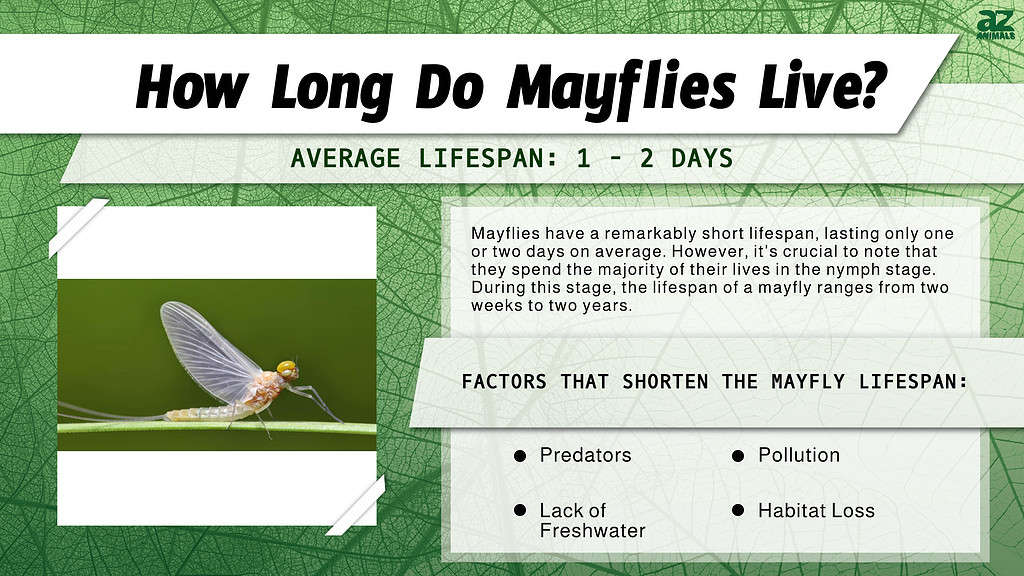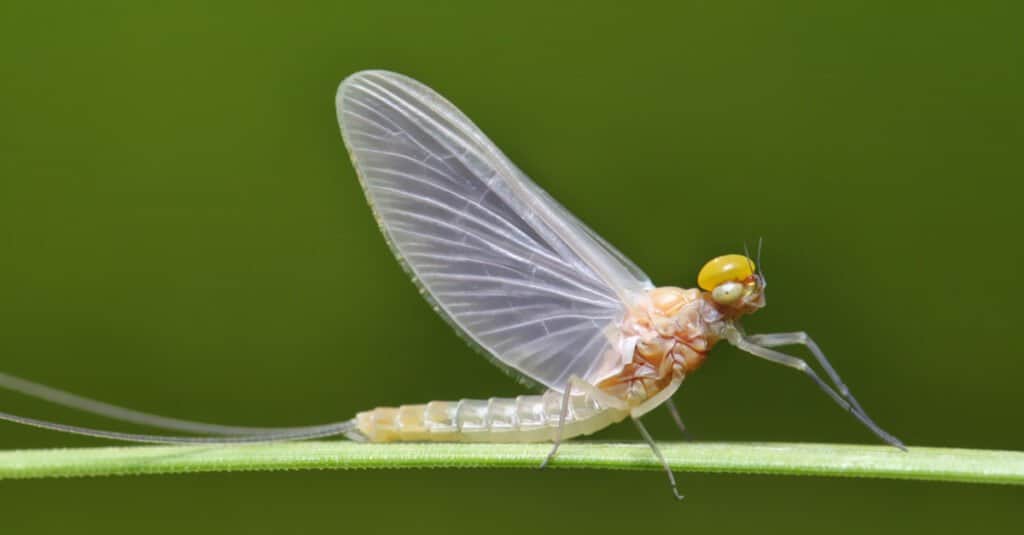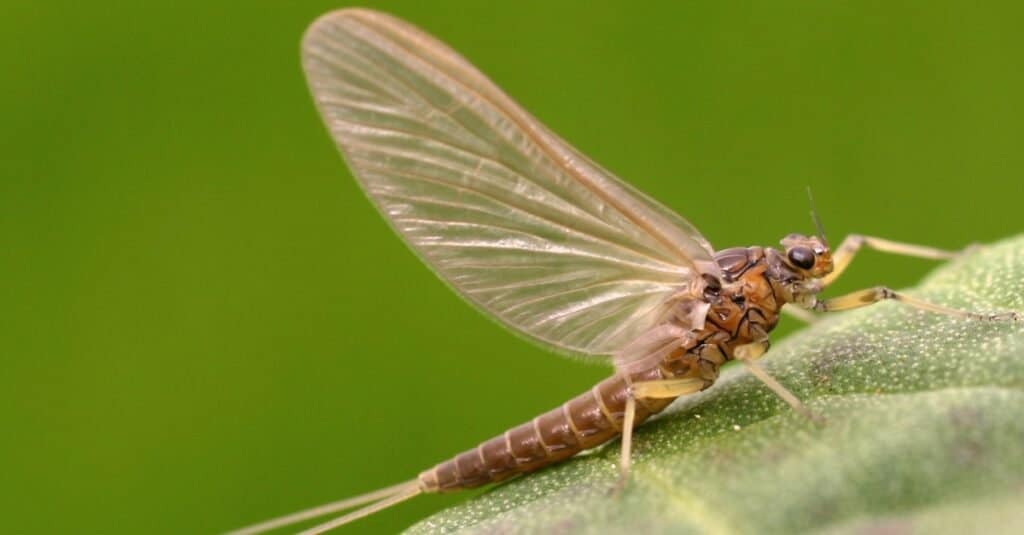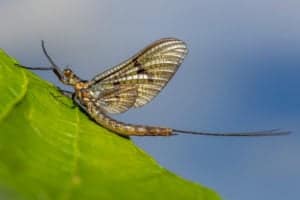
Have you ever heard of or come across a mayfly? You’re probably more than familiar with these aquatic insects if you enjoy fly fishing. They won’t be soaring over the lake in the dead of winter. On the other hand, if you pick up a few rocks, you could see the larval stage of these insects.
So for those of you that have never come across this insect, you’re in for an exciting learning experience! We’ve got all of the facts on this amazing bug. Keep reading to learn all about the mayfly’s lifespan and other fascinating facts that set them apart from other insects.
A Quick Crash Course On Mayflies

Mayflies have large eyes, short, flexible antennae, an elongated, thin body, two or three long tails, and two pairs of flexible wings.
©Achkin/Shutterstock.com
The mayfly, sometimes known as the shadfly, is a species of aquatic insect in the order Ephemeroptera. Its nearest cousins are dragonflies and damselflies. Mayflies are found in about 2,500 different species all over the world. North America is home to over 700 species. Except for the Arctic and Antarctic, mayflies may be found all over the planet.
An ancestor of these bugs evolved on Earth 350 million years ago, way before the dinosaurs. There is no flattened area at the end of the wing, which is a primitive feature that was most likely present in the earliest flying insects.
Artificial flies are used to rig hooks with colored materials such as threads and feathers in fly fishing. Mayflies are the most popular models for these artificial flies.
Mayflies are extremely sensitive to pollution and, as a result, are typically found exclusively in high-quality, low-pollution areas. They are one of the three most often used markers of aquatic ecosystem health, along with caddisflies and stoneflies.
Now that we understand this aquatic bug better, let’s look at the mayfly lifespan.
How Long Do Mayflies Live?

Mayflies are known for their incredibly short lives. Adults have a lifespan ranging from a few minutes to a few days.
©iStock.com/englishriver
The average mayfly lifespan is only one or two days. However, if that sounds shocking to you, it’s important to mention that they spend most of their lives in the nymph stage. When they are in the nymph stage, the mayfly lifespan is between two weeks to two years.
A mayfly’s only purpose in life is to mate. Their mouths aren’t even present since they feed in the air. Many species of mayflies live only two hours, which isn’t enough time for them to accomplish everything they need to do to reproduce. Adult females of Dolania americana have the lowest adult lifespan of any mayfly, lasting less than five minutes.
Now that we know about the very short lifespan of the mayfly, let’s find out how they go through their life cycle.
The Average Mayfly Life Cycle
Because mayflies lack a pupal stage, they experience partial metamorphosis. This entails passing through three life stages: egg, nymph, and adult. Let’s explore each of these in detail.
Egg
Following mating, the female mayflies release their eggs into the water by dipping them in while flying and releasing a few at a time. Another method is to drop the eggs on the surface of lakes and streams, where they sink and disperse among aquatic vegetation and waste.
Nymph
Mayfly nymphs emerge immediately after the eggs hatch. The tiny hatchlings are less than 1 mm long and lack gills, making them look nothing like the adults they will become. Mayfly nymphs may grow up to 3 cm long, passing through numerous phases throughout their development. The nymphs reside in the water, along the bottoms of freshwater environments, where they may hide in the sediment.
Nymphs grow gills as they mature, and some indicators of gender can be recognized through the latter stages of their lives before they finally hit maturity. The nymph loses its outer layer (known as molting) by emptying its innards and filling its midsection with air while floating to the top of the water. Its outer shell cracks open when it reaches the top, revealing the wings.
Adulthood
It might take many months to a year for a nymph to reach the adult stage. Mayflies have two adult phases. In both these stages, they have wings, exist for a brief period, and do not eat. The first of these phases, known as subimago, is a sexually immature state in which the wings are coated in microscopic hairs. Adult mayflies typically emerge into their adult form from late spring to early fall, where they mate in swarms, lay eggs, and then pass away.
Factors That Shorten The Mayfly Lifespan

Mayflies can survive only in the cleanest of waters.
©Dimijana/Shutterstock.com
As has been mentioned, the mayfly lifespan is not a particularly long one. In fact, it is one of the shortest. However, when they are in the nymph stage, they live longer, so they are susceptible to external factors that can impact how long they will live.
These factors include:
- Predators: Predators are drawn to the soft-bodied subimagos. Fish, birds, and other aquatic creatures commonly consume mayflies. They can also be caught with bait on the surface of a lake or stream and eaten dry. Many sections of China and Japan capture and eat adult mayflies.
- Pollution: Pollution continues to endanger mayfly species all around the world. Pollution sources include home and industrial sewage run-off as well as run-off from farmland and urban areas. Pesticides from agriculture pose the greatest serious threat to freshwater ecosystems.
- Freshwater habitat loss: Over the last century, there has been a considerable loss of freshwater ecosystems due to habitat loss, fragmentation, and degradation. Without the proper environment, mayflies will no longer be able to survive.
The photo featured at the top of this post is © bt_photo/Shutterstock.com
Thank you for reading! Have some feedback for us? Contact the AZ Animals editorial team.







